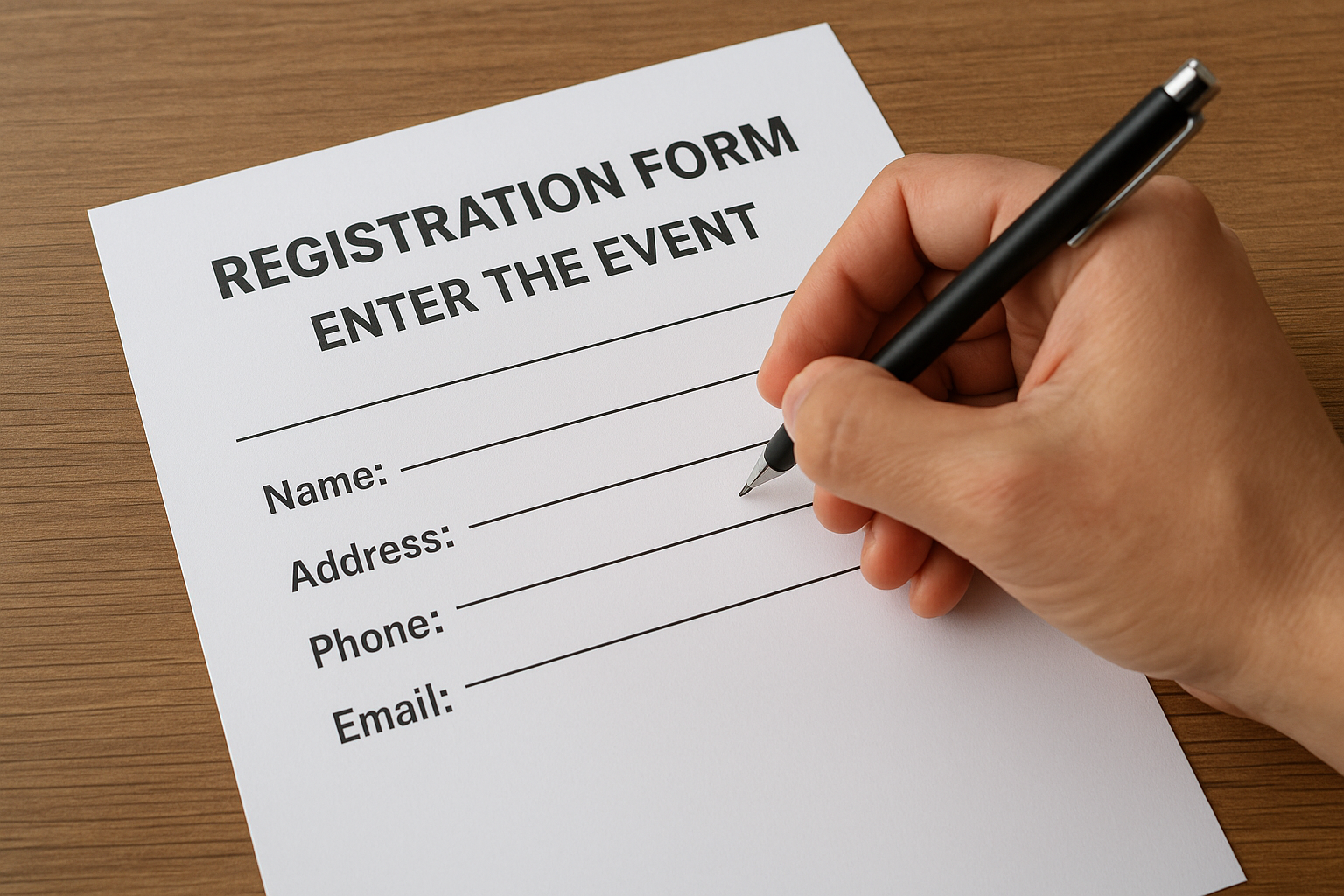Register as an organizer
Click the button below and finish your organizer registration, or fill out the form and we will be in touch to assist you.

Getting people signed up for your event shouldn't be a headache. It's the first thing folks see, so making it easy and clear really matters. Think about it – a clunky sign-up process can turn people off before they even get to the fun part. We'll look at how to make this whole thing smoother, from picking the right tools to handling people when they show up.
Getting the registration process right for your event is a big deal. It's not just about collecting names and payments; it's really the first real interaction people have with your event, and that first impression can set the whole tone. If it's clunky or confusing, people might start to wonder if the actual event will be the same way. We want attendees to feel welcomed and organized from the moment they sign up, whether it's for a small workshop or a huge conference. A smooth process makes everyone happier and makes your job a lot easier too.
Think about it: the registration page or desk is often the very first touchpoint an attendee has with your event. A messy, slow, or confusing sign-up process can leave a sour taste before the event even begins. On the flip side, a clean, quick, and easy registration experience makes people feel good about their decision to attend. It shows you've put thought into their experience from the start.
Beyond just the attendee's feeling, getting the registration details right is super important for planning. Incorrect names, email addresses, or dietary restrictions can cause all sorts of headaches down the line. Accurate data helps you know exactly who is coming, what they need, and allows for better communication before and after the event. It’s the foundation for everything else.
Nobody likes waiting around, right? A streamlined registration process means less time spent by attendees filling out forms or waiting in line, and less time for your staff dealing with confused people or fixing errors. When registration is efficient, it frees up valuable time for both your attendees to get excited about the event and for your team to focus on other important planning tasks. It's a win-win situation that makes the whole event run more smoothly. Getting your event registration sorted efficiently is key.
Picking the right system for signing people up for your event can feel like a big decision. It’s not just about collecting names; it’s about making the whole process smooth for everyone involved. Think about what you really need. Do you have a small workshop or a huge conference? The software needs to handle that. Also, how easy is it for people to use? If it’s confusing, they might just give up. We want to make it simple, right?
When you're looking at different registration tools, keep an eye out for a few key things. First, it should be easy to set up and use. Nobody wants to spend days figuring out complicated software. Second, it needs to be flexible. Can you change the questions you ask? Can you add different ticket types? This is important for getting the right information. Third, think about payments. It should handle different ways people like to pay, like credit cards or maybe even digital wallets. And don't forget about support. If something goes wrong, you want to know someone can help you fix it quickly.
Here’s a quick look at what to consider:
There are quite a few options out there, and they all do things a little differently. Some are really good for big, complex events, while others are simpler and better for smaller gatherings. It’s a good idea to check out a few of the top ones, like Swoogo, Hopin, Cvent, and RegFox. Many of them offer free trials or demos. This is your chance to actually play around with the software and see if it feels right for your event. You can discover the leading event registration software options to get a better idea of what's available.
So, how do you pick the one that’s best for your event? Start by thinking about your goals. How many people are you expecting? What kind of information do you need to collect? Do you need to track different ticket prices or offer discounts? Once you know what you need, you can compare the features of different platforms. For example, if you need to collect detailed attendee information for future marketing, a system with strong data management and CRM integration would be a good choice. If your main concern is making the payment process super easy, look for platforms with multiple payment options and a straightforward checkout. Ultimately, the best system is the one that makes your life easier and your attendees' experience better.
Choosing the right registration system isn't just a technical choice; it's a strategic one that impacts attendee satisfaction and your event's overall success. Take the time to research and test different options to find the perfect fit.
Making your event registration form easy to fill out is a big deal. Nobody wants to spend ages typing in their life story just to sign up for something. Let's break down how to make this part of the process much smoother.
Think about what you really need to know. Most of the time, just a name and email address are enough to get someone registered. You can always ask for more details later, maybe in a follow-up email or closer to the event date. Asking for too much upfront can make people click away before they even finish. It's like going to a store and having to fill out a form just to look at a shirt – it's a bit much, right?
Use tools that make filling out the form less of a chore. Dropdown menus are great for selecting from a list, like ticket types or dietary options. Checkboxes work well for multiple selections. And if you can, use autofill features where possible, especially for things like addresses. It saves people from typing the same info over and over. Little things like this make a big difference.
Sometimes, a field might be a bit confusing. Instead of just a blank box, add a little note right next to it. This could be a tooltip that pops up when you hover over it, or just a short sentence explaining what you need. For example, if you need a business name, you could add a small note saying, "If not applicable, please leave blank." This helps prevent errors and keeps the process moving.
A registration form that's too long or confusing is a major reason people abandon the signup process. Keep it short, sweet, and to the point.
These days, people expect things to just work, especially when signing up for something. That's where digital tools really come into play. Think about making a special spot on your website just for signing up – it needs to look good and work well on phones, because let's face it, most people are browsing on their phones. Making this digital space easy to use is key. When someone signs up, they should get an email right away confirming everything. It's also smart to include a way for them to add the event to their calendar. This little bit of automation saves you time and makes the attendee feel looked after. Plus, you want the actual sign-up pages to be super clear and simple. No one wants to hunt around for buttons or get confused by what to click next. It's all about making the whole process smooth so people actually finish signing up. We can also look at how to get more people to sign up using digital marketing tools.

The moment attendees arrive, the onsite check-in process is their first real interaction with your event. Making this smooth and quick is super important. A clunky or slow check-in can sour the mood before anything even starts. Think about it: people have traveled, maybe dealt with traffic, and they just want to get inside and enjoy themselves. Long lines and confused staff aren't exactly a great welcome.
Using technology can really change the game here. Instead of just paper lists, consider using tablets or even mobile apps for check-in. Many systems let you scan QR codes directly from a guest's phone, which is way faster than searching for a name. Some advanced systems even use facial recognition, though that's a bit more complex and might raise privacy questions for some folks. The key is to have a system that syncs attendee data in real-time, so if someone registered late or changed their ticket, the staff can see it instantly.
Walk-ins are always a possibility, and you need a plan for them. Having a dedicated station for on-site registration is a good idea. Make sure the staff there have a quick way to get new attendees into the system and print badges. It’s also helpful to have a clear pricing structure displayed so there’s no confusion. Don't let walk-ins slow down the pre-registered lines.
Even the best tech won't work if the people using it aren't prepared. Your check-in staff needs to know the system inside and out. They should be trained on how to handle common issues, like a guest not finding their name or a problem with a QR code. Role-playing different scenarios can be really helpful. Make sure they know who to ask if they run into a problem they can't solve quickly. A well-trained team makes all the difference in keeping things moving and making guests feel looked after.

Getting the registration part right is pretty important for any event. It’s not just about collecting names; it’s about making a good first impression and making sure everything runs smoothly from the get-go. Think of it as the handshake before the main event. If that handshake is awkward or fumbles, people notice. We want people to feel welcomed and informed right away, not confused or frustrated. That’s why focusing on these best practices can really make a difference in how your event is perceived and how many people actually show up.
Before you even think about setting up a form, take a moment to figure out what you actually want to achieve with your registration process. Are you trying to get a specific number of people to sign up? Maybe you’re aiming for a certain type of attendee, like professionals in a particular industry or students. Or perhaps you need to collect detailed information for follow-up or future events. Knowing these goals helps shape everything else, from the questions you ask on the form to how you promote the event. It’s like having a map before you start a road trip; it keeps you on track.
People have different ways they like to pay for things, and making it easy for them is key. If your event requires payment, offering a variety of options can really help boost sign-ups. Think beyond just credit cards. Including options like PayPal, Apple Pay, or even region-specific payment methods can remove a barrier for many potential attendees. Making the payment process simple and secure is a big deal. It shows you’ve thought about your attendees’ convenience, and that kind of attention to detail goes a long way. A smooth payment experience means fewer abandoned carts and more confirmed registrations. You can explore different payment gateway options to see what fits best.
Once the event is over, the work isn't quite done. Getting feedback from attendees about their registration experience, as well as the event itself, is super helpful. What worked well? What could have been better? This information is gold for planning your next event. You can send out a simple survey after the event, perhaps including a question specifically about the registration process. This feedback loop helps you continuously improve and make future events even better. It’s a way to learn from your attendees and show them you care about their experience.
So, getting people signed up and checked in for your event doesn't have to be a headache. By keeping things simple, using the right tools, and making sure your staff is ready, you can really make a difference. A smooth start sets a good tone for the whole event, and happy attendees are more likely to come back. It’s all about making it easy for everyone involved.
Making your event's sign-up process easy is super important! It's usually the first thing people see, so a smooth start makes a great first impression. Plus, it helps you get accurate info about who's coming, which is key for planning. And, of course, it saves everyone time – you and your guests!
Think about using software that's simple to use on phones and computers. Look for systems that let you easily collect names, emails, and what kind of ticket people want. Features like automatic emails to confirm sign-ups and clear instructions on the page really help a lot.
Only ask for the absolute must-have information, like a name and email. Use simple tools like dropdown menus or checkboxes instead of asking people to type a lot. If you need more info, add little hints or tips to explain why you're asking.
Yes! Having a website or page for registration that works well on phones is a must. Also, setting up automatic emails to confirm registrations and sending out reminders is a great way to keep everyone informed and excited.
Using technology like QR codes for quick check-ins or having self-service kiosks can make things much faster. Also, make sure your staff knows exactly what to do and is ready to help if there are any issues, especially with people who sign up at the door.
First, know exactly what you want to achieve with your registration, like how many people you want to attend. Offer different ways to pay, like credit cards or digital wallets. After the event, ask people about their experience to find out what worked well and what could be better next time.
More blogs
Click the button below and finish your organizer registration, or fill out the form and we will be in touch to assist you.